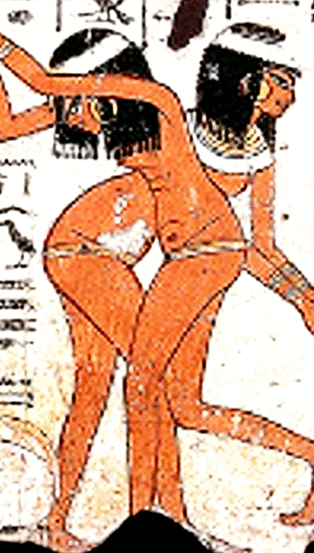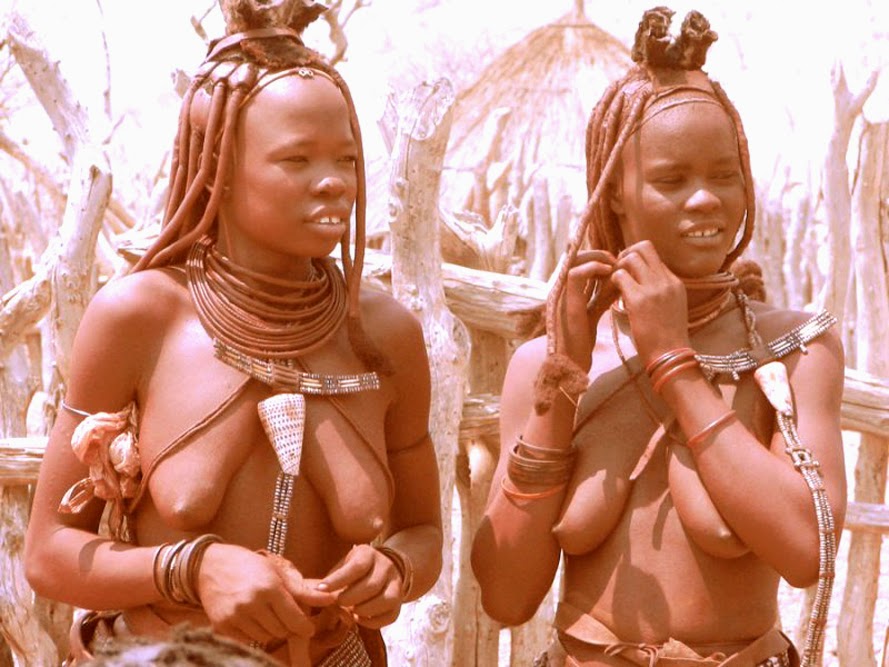The furthest we managed to get to in the extant stocks of vocabulary of ancient tongues are words made of three letters (root+letter).
Not surprisingly, perhaps, the first body part human beings sought to cover is the cunt. We know that because the triliteral KSʼ “covering, clothes” is a suffixed (root+letter) extension of the bilateral *KS “cunt”.
The third letter of KSʼ is a “hamza”, a short “a”. Though not a rule, this astonishing letter appears to be the invention of one of two ancient nations in southern Arabia, the closet geographical area to eastern Africa from the which the earliest immigrants crossed into the southern tip of the Red Sea into Arabia.
Some would have found pockets capable of sustaining the few dozen members of each tribe but the rest had to move on to the rest of the world, probably in successive waves the first of which may have hit the longest road taken by humanity some 50,000 years or more.
Surprisingly, exists in Akkadian an entry that appears to equate “humanity” with the act of corssing:
abrātu: [Human → Family] mankind, humanity, populace.
It looks to us from the root *ʻB which has a number of meanings including “great water”. From it is *ʻBr “to cross”. Its water patronage may lead to the reasonable assumption of actions entailing crossing a sea or a river.
Some scholars confused the Akkadian “abrātu” and the old Arabic sing. ʻaber “crosser”; ʻauboor “crossing” with “Hebrew” presuming the ‘h’ is a substitute for (ʻ) but it is not. ‘Hebrew” appears to be from the root *ḤP that produced ḤPr. It is migrated in Arabic to Ḥbr “a rabbi, a Jewish religious scholar”.
The origin of the common “Hebrew” is probably this Akkadian entry:
ḫāpiru: [Human being] (a sort of) vagrant.
This very word exists in Syrian vernacular ‘ḫāpiri’ (vocalised ḫāfiri), a very common ‘f’ substitution for ‘p’ in Arabic. It has the same meaning as its Akkadian counterpart “vagrant, doing menial work, pauper, poor, powerless” in addition to other adjectives. Recently it surfaced strongly in worn-torn Syria to refer to peasants in southern Syria. An important village 35 KL north of Damascus is named Upper “Ḥafeer”.
We have looked in our extensive database for clothes in ancient times. It looks boys and girls had the same garb covering the body down to the ankles with a sort of a sleeveless tunic inserted through the head. Girls appear o have continued to play with boys until they had their first period. After that they joined the community of female relatives to learn the arts of running homes, and probably began to cover their pussys.
Other types of clothes include a large sort of shawl covering the upper part of the body in winter, and a wide cloth one side of which was pushed over one shoulder to the middle of the back.
Another is called drʻ “shield”. It can be presumed to cover the chest but it is not clear if this type of garb covers the back as well.
We found no root that means or could mean underwear but they were known during the triliteral period (more than 5,000 years ago) as “lower” or “bottom” clothes as in Akkadian:
šupālītu: [Clothing] 1): undergarment, underwear, a shirt; 2): a foundation.
We have no specific description for this type of underwear but the word usually means from the waist to the feet.
A type of trousers with baggy bottom appears to have been developed more than 5,000 years ago but it looks it was designed for comfort rather than an attractive design. Some people still wear it and it was very common during the Ottoman occupation of the Levant. It is known as ‘sherwal’ (*ŠR/*Wl), literary “to seep to a distant place”. A variation is “SR/WL”, literary “to walk to a distant place”. Some speakers use it today to mean underwear.
The Italian ‘camicia’ “shirt” is from Arabian *KM/MŠ, literary “sleeve, held by hand, cloth (qumash)”.
Jacket is Arabian. The Online Etymology Dictionary claims the origin is from Spanish Jaco “from Arabic ‘shakk’ “breastplate”. We can’t confirm that. ‘Yaqa” in Arabic means “collar” and it looks a better origin of the Andalusian (Spanish) Jaco.
We were surprised to find headdresses common thousands of years ago with an attestation in Akkadian:
aparakku: headdress (kind of), coifs (kuffiah in Arabic).
Flax and cotton were known thousands of years ago and both are in Akkadian:
kitû: [Clothing] flax, linen, tunic 1) plant: flax (Arabic “kittan”),
kitû: [Clothing] flax, linen, tunic 1) plant: flax
šīpātu 1) wool; 2) a fleece from sheep; 3): fleece of cotton / of trees.
The English ‘cotton’ is from Arabic “Quton”; root *QṬ “cut off”. Cut itself is thought to be from North Germanic kut, so most probably from ancient Arabian.
The Akkadian word for “cut” appears to be this:
qatû B: [Army → War] to end, to finish (D) to bring to an end, to destroy.

The first ancient nation to initiate covering pussys and consequently clothing humanity appears to be the Udite, from a root that doubles as the proper noun of its chieftain ʼD, known in later times as the god Ad, Adad, Hadad, etc. This is the nation that identified God with a famous bilateral IL (ʼL), the origin of the subsequent IL, EL, Elohim, ELI and Allah.ʼD is the origin of ʼDb (Adab) “good manners, politeness, literature, banqueting, civility, refinement, courteous behaviour, the quality of being polite and respectable, correct behaviour that shows respect, improvement of mind or character, advanced development of the human body, mind, etc; the intellectual development,” etc., we have no means to confirm covering the private part of women was motivated by religious beliefs. The plausible reason was to safeguard the decency and decorum of women and provide privacy during menstruation.
Sometimes in the late Stone Age, a stone meteorite appears to have fragmented during Earth entry and showered a wide area in eastern Arabia. Two large fragments hit Mecca and Taif as well as other areas in the vicinity.
The impact in the valley of mountainous Mecca appears to have been sufficiently significant to create a deep crater that forced subterranean water to gush and create the famous “Zamzam” spring, a later name of religious origin, but the original name is preserved in the name of “Kaaba” itself and attested in Akkadian.Mecca became a prehistoric site for pilgrims who also came to buy kohl and glassy stones for firelighting, probably from the meteorite . Some historians claimed the pilgrims were naked, and separating men from women was instituted.We know this because the triliteral ḤJb (Ḥajab) means “curtain, obscure, separate”. The root is *ḤJ, originally ḤG and it survives to this day in its root state to mean the annual Hajj pilgrimage to Mecca.
Some Islamic historians claimed the pilgrimage was turned to a mass orgy but most of these historians are biased in favour of glorifying Islam and dishonouring the previous eras. However, extant is a short description of men shaving their head hair for the Hajj using flower to facilitate the removal of the hair.Linked to this description are people waiting for the men to shave their hair so they can begin collecting the mixture of hair and flower to remove the hair and use the flower for food.
This is an advanced age because it assumes the onset of the Agrarian Era and the development of tools to grind the wheat, probably 6,000- 7,000 years ago or earlier.The poor people were called ʻR. It is still used as a root and it has a large number of meanings including “many, numerous, multitude”. These were later knows and ʻRb (ʻRab) “Arabs”.
From the same root is ʻRa “naked, nakedness, nudity” but also ʻRwa “buckle, clasp, fastener, fastening; a brooch, clasp”, but probably originally no more than a twig tied in the middle. So it appears they were not totally naked but sparsely covered with pieces of leather clasped together.
Arabs appear to have staged the first mass rebellion in history against the tribal Arabian aristocracy. Originally, they were from the same tribes but probably joined by fresh immigrants from east Africa. Many were employed as farmers and herders and collectors of frankincense and “murr”, a natural antibiotic produced from certain trees in the mountainous south eastern parts of Arabia.
The increased agricultural activity followed by expanding trade created a massive need for workers. With time workers became numerous and the rebelled against the feudal tribes, overpowered them and forced them to flee from Arabia.
Interestingly, a brief account of this uprising is reordered in the Quran (Arafaf 74) but we rely only on etymology.
The feudal tribes moved to Egypt, Syria and Mesopotamia and established their historical empires in their new homes. The Arabs in Arabia enjoyed the possessions of the feudal tribes for some time but they lacked the experience and the knowledge of the feudal tribes to run the country.
Soon, Arabia went into a bleak historical dark age that lasted some 3,000 years or more. Poverty stricken, pillaging became a major source of survival but that only led to impoverishing each other. Using powerful camels, they attacked trade routes and border towns of the neighbouring empires. The Assyrians marched to Arabia to subdue some Arabs and border skirmishes were many.
A drawing of Assyrian soldiers chasing Arabs is here:
https://plus.google.com/+ThebookoforiginsNetAdel_S_Bishtawi/posts/ZwhacV7v8hh
In Akkadian:
arbāiu (noun and adjective; feminine: arbītu;) [Humanities → Geography → Countries] an Arab, Arab (adjective); Arubu: Arabia; Bāzu: the Arabian Desert; Arbītu: Arabic (language).
Also these entries to be read with Arabs in mind:
erû (3): [Human → Body] to be naked, to be in the nude: to be destitute, to be without clothes on, to be very poor D: (hair) to strip a head bare, (wind) to strip (trees, ground …), to strip a woman for childbirth, to prepare a woman for childbirth [erû qablītu]: to empty a container.
These as well, as far as we can judge:
arbu (1): [Country → Agriculture] said of a meadow: ugāru: waste, uncultivated;
arbu (2): a fugitive, a runaway;
arbû: [Animals → Insects] locust; tibût erbî locust swarm;eli erbû mād: more numerous than locusts [this is a telling reference of the huge number of the rising tribes of Arabs]; erib garābi: (plant name: “leprosy locust”); erib nāri: (water insect ?); erib tâmti: (crustacean: sea-cicada-scyllaridae-?); erib turbu ‘ ti: dust-storm locust;
arbūtu (1): [Army → War] desolation
arbūtu (2): [Army → War] flight, rout.
The G-String of prehistoric times
The connection between clothes and a woman’s private part is evident in the fact that kisa, which means in Arabic “costumes”, is a triliteral from *KS “cunt”. From the same root is kasam “appearance, shape, form, fashion,” and kasal “idleness; inactivity; indolence; languor; lassitude; laziness; sluggishness”. A bodily and mentally state to be expected following an extended session involving the root.
It does also look that *KS (vocalised kiss or kus) is a good candidate for parenting both “sex” and “kiss”.
The origin of “sex” is “uncertain” and the origin of kiss is confused unless one is convinced the word is the sound of kissing, or the Old English “coss” is unlike “kus”.
Akkadian has this entry from the same root *KS (kus):
kusītu: [Clothing] robe, gown, dress, mantle, flowing garment.
This is very similar to the extant Arabic in which ‘kasait’ is “to buy clothes to dress somebody”. More importantly, perhaps, is the use by Assyrians and Babylonians of the same linguistic root to describe very advanced types of garments in their times.
The word ‘hab’ in Arabic is “alarmed by; be afraid of; dread; fear; frightened by; scared of; terrified by; be awed by; respect; respect; venerate,” etc.. Some of these words maybe worthy of tribal chieftains or kings who appear to have distinguished themselves by wearing the skin of a number of animals including tigers, cows, sheep and goats.
Small pieces of any of the skins available would be sufficient to make the prehistoric knickers. The main piece covers and holds the cunt. The leather piece was attached from both front and back to two bands of leather or some sort of flax, and both ends were attached to a band around the waist.
How do we know it was a band used in this way or a similar way?
it could have been made in other ways using available material. The thong or G-String of Egyptian girls in the painting is obvious but we also have this word in Akkadian:
erru (2): [Country → Agriculture] 1): a ring, a band; 2) a ring / a washer for peg; 3) a headband – metal or cloth.
This word in interesting because it doesn’t describe bands or rings as such but solutions invented by “naked people”: erru “naked”. The root is not with the vowel ‘e’ but with ayn (IPA ʻ), the first letter of “Arabs”.
This may suggest bras or similar coverings for breats were not used. Of course as all girls know the bra doesn’t just cover the breasts but hold them as well. They become larger and gravity pulls them down like everything else. The long exposure of the nipple may affect its shape.

The Himba people of northern Namibia described as the most beautiful in Arica; http://www.pbase.com/dror_yalon/image/130425690
There are two words in Akkadian that mean “nipple”:
1. ṣertu : [Animals] breast (woman), tit, teat nipple, udderك
2. tulû : [Human → Body] 1) a breast (male and female) , a nipple.
The first word was covered in a previous post and it means “pouch” because our ancestors thought it looked like a pouch with a protrusion similar to the severed end of the pouch after gathering its ends in a way similar to the belly button or “ṣerrah” in Arabic from the same Akkadian root *ṢR.
The second word is in Arabic ‘thu’lul’ “wart”. The word isn’t used to refer to a nipple because it is a grave insult. We’ve checked the word again and it looks from a very ancient root *Tʼ “two”. This word is critical because it is a record of the very early stage of human awareness. It took human beings a very long time to realise they have an entity all of its own. The realisation produced *ʼN “here, in this place, I”. A person approaching to join “I” is ‘Tʼ’ “two, another entiry, you singular”. We think it is attested in the second part of this Akkadian word ‘šittān’ “two thirds”, i.e. *TA > *Tʼ. It looks the origin of Proto-Germanic *twa and the PIE *duwo or dwo, the three to mean “two”. The High German Zwo also means ‘two’ but the root is different ‘*ZW “double, two, a pair, husband and wife, goose” in reference to its two legs. The concept of the earliest scales is from this bird ‘miZAn’ “scale, weighing tool”.
We have found no words that mean bra or something similar. However, in later times the advent of sleeveless tunics for both boys and girls would have covered the breasts. Before that it seems women either did not cover their breasts or some women partly covered them with thick or multiple bands around the neck that loosely extended over the breasts.
Some ancient Egyptian paintings depict women with “G- Strings” and over-handing loose “bras”. Other paintings show women fully dressed and some appear overdressed. Clothes were expensive and costumes appear to have been a sign of wealth and power. The poor had to find their own garbs.
In our time girls are getting taller, prettier, and sexier and they are already driving men mad, so for what reason most of them are abandoning at least 5,000 years of part or full clothing to the G-String of prehistoric times?
Not that it is sudden. Women’s clothes have been getting shorter for at least a hundred years. Some female bodies are not much smaller than men but their shorts are much shorter than men’s and at their lowest Simultaneously while at the same time the shorts are at their lowest possible point below the stomach.
Older girls maybe said to be driven by the need to look more attractive to attract more attention, but then very young girls have very short shorts though not much shorter by boy’s shorts by much. It also looks that some mums are imitating their daughters by wearing shorter dresses. Mums usually buy their daughters’ dresses including shorts with “cute cuts” so the midriff-baring is accelerating faster.
A report by the American Psychological Association confirms evidence for sexualisation of girls and women and warns of consequences that include negative effects in a variety of domains, including cognitive functioning, physical and mental health, sexuality, and attitudes and beliefs.
The girls’ sexualisation trend is said to have a negative impact on other groups (i.e., boys, men, and adult women) and on society more broadly. Exposure to narrow ideals of female sexual attractiveness may make it difficult for some men to find an “acceptable” partner or to fully enjoy intimacy with a female partner.
Maybe so but we sometimes forget what life is all about. The briefest possible summing up is “man, woman and child”. We brag about ‘free will’ but we are mostly pre-programmed to propagate because it is the only way to perpetuate life.
Marriage is still important for girls and boys, but both seem to be delaying marriage for a number of reasons the most pressing of which is economic. It is taking longer to prepare young people for complex jobs and longer to find a job.
Religious and societal pressures to conform are weakening and the weakness is likely to continue maybe indefinitely. Free market and competition are not just economic prerequisites. Supply and demand works for goods and services and much as for relationships. At difficult times like these the sure way to attract buyers is to offer the best product with the best appeal at the most economical price possible.
Probably this is what females are doing consciously or subconsciously. The best price for marriages nowadays is zero. You can’t get it cheaper than that. The other factor is to present the most attractive package possible with many girls offering free samples for longer and longer periods.
It is true that girls are getting prettier and sexier but this very observation maybe the reason why they feel they have to compete harder.
Maybe it should be left for the girls. Our prehistoric mums were successful and our future mums will be successful as well. We should trust girls. Other members of societies fearing negative effects may want to offer girls more protection and less advice.
A copy of the report is here:
http://www.apa.org/pi/women/programs/girls/report-summary.pdf
Here is a list of the oldest extant Akkadian words related to costume, hairdo, brooches, etc.:
aparakku: headdress (kind of), coif;
edēqu: to dress, to clothe, to get dressed;
gallābu: [Professions] barber, hairdresser;
kazāru: [Human → Hygiene] to coiffure, to curl / dress one’s hair, to have a hairdo / (special) hairstyle;
kezēru: [Human → Body] to give someone (king, woman, animal) a (special kind of ) hair-do, to dress the hair of [nēbeḫ / parṣī kezērim]: a payment relating to the function of “kezretu”;
kusītu: [Clothing] robe, gown, dress, mantle, flowing garment;
kuzippu: [Clothing] garment, clothes, suit, costume, garb, cloak;
labāšu (N): [Clothing] to clothe oneself, to get dressed
lamaḫuššu: [Clothing] ( a kind of robe / garment / dress / garb);
mugabbîtu: [Professions] a seamstress, a needlewoman, a dressmaker;
mugabbû: [Professions] a seamster, a stitcher, a dressmaker, a tailor, a clothes-mender;
pūṣāya: [Professions]: a launderer, a laundress;
sagdullu: [Clothing] a headdress;
tudittu: [Clothing] a dress pin, a brooch
baštu: [Moral life → Quality] : 1) (divinity, person) dignity, source of pride (?), high rank (?), high position / status (?), title (?) 2) (in personal name): protective force 3) (building, orchard): pride (of the city, land …), self-esteem 4): [ṣubāt bāštu]: formal dress –
See what the bāštu looks like here:
https://plus.google.com/+AdelBishtawihistorian_and_novelist/posts/WHh83hf77jN
Image: The Himba people of northern Namibia described as the most beautiful in Arica;
http://www.pbase.com/dror_yalon/image/130425690
Last modified: June 1, 2023



